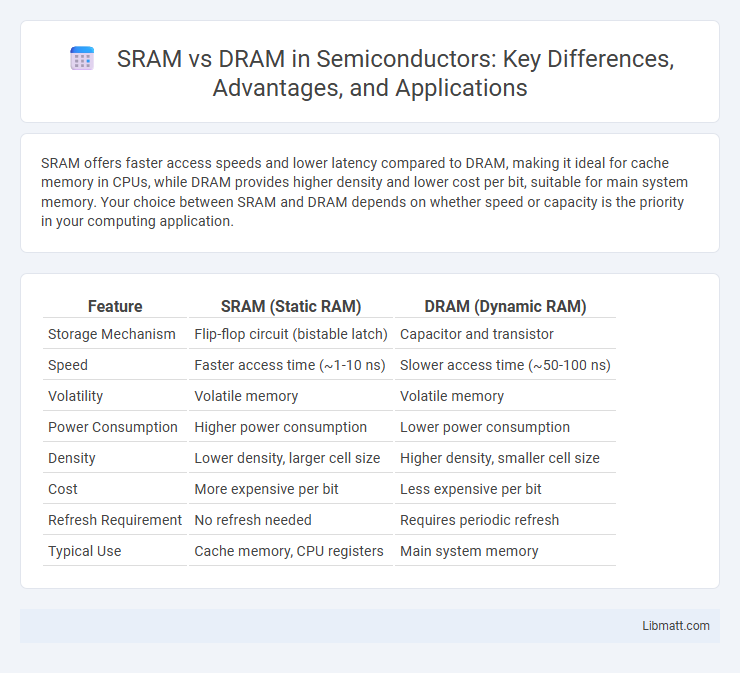SRAM offers faster access speeds and lower latency compared to DRAM, making it ideal for cache memory in CPUs, while DRAM provides higher density and lower cost per bit, suitable for main system memory. Your choice between SRAM and DRAM depends on whether speed or capacity is the priority in your computing application.
Table of Comparison
| Feature | SRAM (Static RAM) | DRAM (Dynamic RAM) |
|---|---|---|
| Storage Mechanism | Flip-flop circuit (bistable latch) | Capacitor and transistor |
| Speed | Faster access time (~1-10 ns) | Slower access time (~50-100 ns) |
| Volatility | Volatile memory | Volatile memory |
| Power Consumption | Higher power consumption | Lower power consumption |
| Density | Lower density, larger cell size | Higher density, smaller cell size |
| Cost | More expensive per bit | Less expensive per bit |
| Refresh Requirement | No refresh needed | Requires periodic refresh |
| Typical Use | Cache memory, CPU registers | Main system memory |
Introduction to SRAM and DRAM
SRAM (Static Random-Access Memory) and DRAM (Dynamic Random-Access Memory) are two primary types of volatile memory used in computing systems. SRAM uses bistable flip-flops to store each bit, providing faster access times and lower latency, making it ideal for cache memory. DRAM stores bits in capacitors that need constant refreshing, offering higher density and lower cost per bit, commonly used as the main system memory.
What is SRAM?
SRAM (Static Random-Access Memory) is a type of volatile memory that uses bistable latching circuitry to store each bit, enabling faster access times compared to DRAM (Dynamic Random-Access Memory). It does not require periodic refreshing, which reduces power consumption and makes it ideal for cache memory in processors. Your devices benefit from SRAM's high speed and reliability for storing critical data that needs quick retrieval.
What is DRAM?
DRAM (Dynamic Random Access Memory) is a type of volatile memory that stores each bit of data in a separate capacitor within an integrated circuit, requiring constant refreshing to maintain data integrity. It offers higher density and lower cost per bit compared to SRAM, making it widely used for main system memory in computers and mobile devices. DRAM speed is slower than SRAM due to its refresh cycles, but its capacity and cost efficiency make it essential for large-scale memory applications.
Key Differences Between SRAM and DRAM
SRAM uses bistable latching circuitry to store each bit, making it faster and more reliable than DRAM, which stores data using capacitors that require periodic refreshing. Unlike DRAM, SRAM consumes less power during operation but requires more transistors per cell, resulting in higher cost and lower density. Your choice between SRAM and DRAM depends on whether you prioritize speed and stability or cost-effectiveness and memory capacity for applications like cache versus main memory.
Memory Architecture and Design
SRAM uses a six-transistor (6T) memory cell design that stores data using bistable latching circuitry, enabling faster access times and lower latency compared to DRAM. DRAM relies on a single transistor and capacitor pair to store each bit, requiring periodic refresh cycles to maintain data integrity due to capacitor charge leakage. Your choice between SRAM and DRAM will significantly impact memory speed, power consumption, and scalability depending on the architectural requirements of your application.
Speed Comparison: SRAM vs DRAM
SRAM offers significantly faster access times than DRAM, typically in the range of 1-10 nanoseconds compared to DRAM's 50-70 nanoseconds, making it ideal for CPU cache memory where speed is critical. The static nature of SRAM, with its six-transistor cell design, eliminates the need for refresh cycles, resulting in instantaneous data access. DRAM's reliance on capacitors that require periodic refreshing causes slower access, but it compensates with higher density and lower cost per bit for main system memory.
Power Consumption Analysis
SRAM consumes significantly less power than DRAM due to its design, which retains data without frequent refresh cycles, making it ideal for cache memory in processors. DRAM requires constant refreshing, leading to higher power consumption, especially in large memory arrays used for main memory storage. Understanding these differences helps you optimize your system's energy efficiency based on the specific memory type utilized.
Cost and Scalability Factors
SRAM offers faster access times and requires less power but is significantly more expensive and less dense than DRAM, making it less scalable for large memory needs. DRAM, with its simpler cell design, provides higher density at a lower cost, ideal for scaling up memory capacity in devices like computers and servers. When optimizing Your system, choosing between SRAM and DRAM depends on balancing cost constraints with scalability requirements for performance.
Common Applications of SRAM and DRAM
SRAM is commonly used in cache memory for CPUs, where high speed and low latency are critical for boosting processing performance. DRAM is predominantly employed as the main system memory in computers and mobile devices due to its higher density and cost-effectiveness compared to SRAM. Embedded systems and graphics cards often integrate both SRAM for fast access and DRAM for large capacity storage.
Choosing Between SRAM and DRAM
Choosing between SRAM and DRAM depends on factors like speed, power consumption, and cost. SRAM offers faster access times and lower latency, making it ideal for cache memory, while DRAM provides higher density and lower cost per bit, suitable for main memory in computers. Your decision should weigh the need for speed against budget constraints and memory capacity requirements.
SRAM vs DRAM Infographic

 libmatt.com
libmatt.com